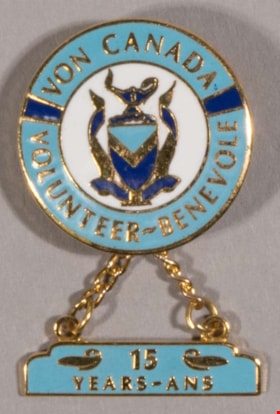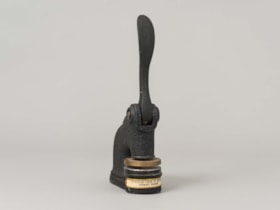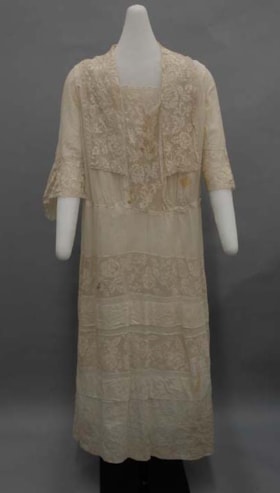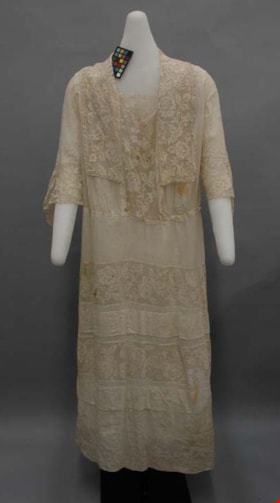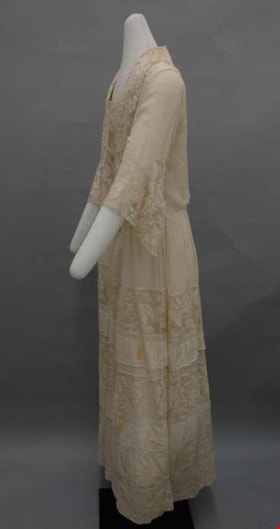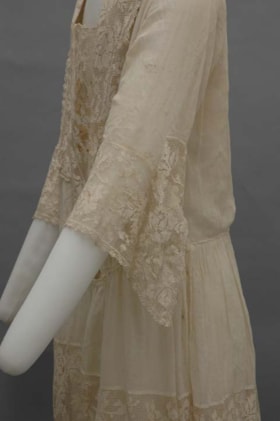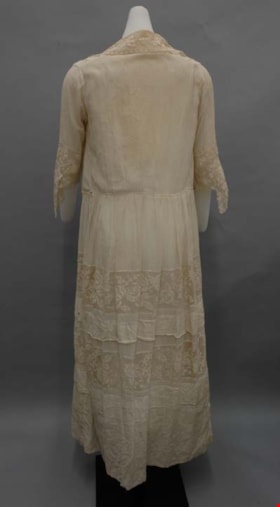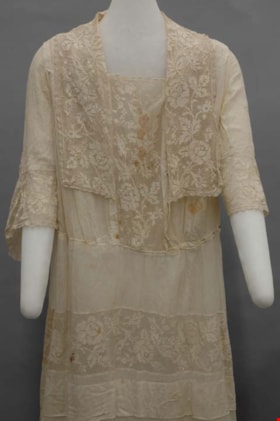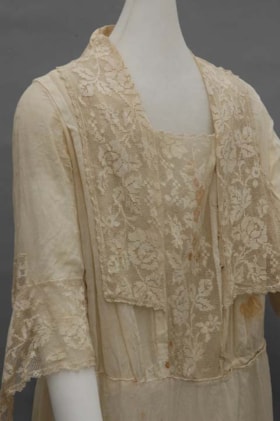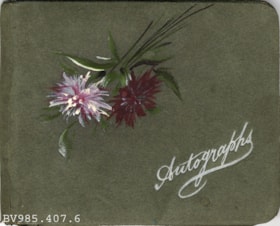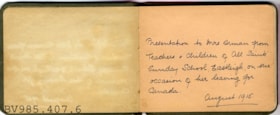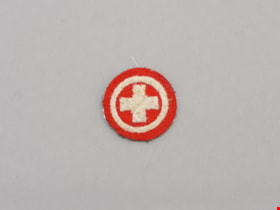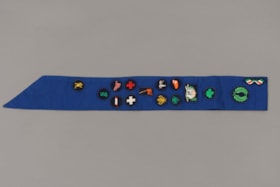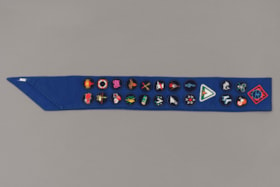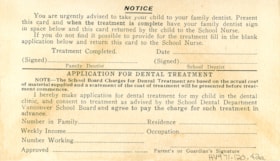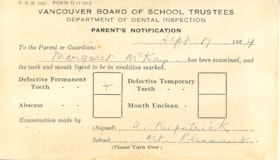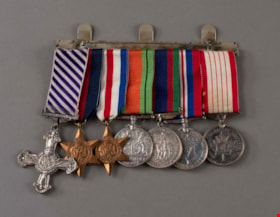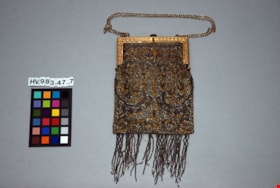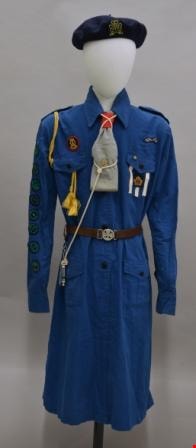Narrow Results By
lapel pin
https://search.heritageburnaby.ca/link/museumartifact47439
- Repository
- Burnaby Village Museum
- Accession Code
- BV004.85.51
- Description
- Pin; blue, white, and gold; "VON Canada" "Volunteer - Benevole" "15" "Years - Ans"; Victorian Order of Nurses for Canada.
- Category
- 08. Communication Artifacts
- Classification
- Documentary Artifacts - - Memorabilia
- Object Term
- Commemorative
- Marks/Labels
- VON Canada / Volunteer - Benevole / 15 / Years - Ans
Images
Wax seal
https://search.heritageburnaby.ca/link/museumartifact36456
- Repository
- Burnaby Village Museum
- Accession Code
- BV985.81.2
- Description
- Victorian Order of Nurses (V.O.N.) seal is the tabletop stamping type which imprints the words "VICTORIAN ORDER OF NURSES" and "BURNABY BRANCH"; official; stamper is black metal, lever at top; "MADE IN CANADA" at side of base; seal disc is brass; label at front transcribes the words on the seal.
- Object History
- The Victorian Order of Nurses for Canada is a non-profit charitable organization created for the purposes of home care and social services established in 1898 to perpetuate the memory of Victoria the Good. The Burnaby Branch of the Victorian Order of Nurses (VON) was established in 1912 with Miss Colhoun as its first nurse. Florence Hart was born in 1898 in New Westminster, and moved to Burnaby when she was 13. Her family lived in what is now known as Hart House. Both Florence and her husband Harold Godwin were awarded life memberships from the VON (Victorian Order of Nurses) for more than half a century of service. Hear her discuss her involvement with VON during the Great Depression: https://search.heritageburnaby.ca/permalink/oralhistory13 https://search.heritageburnaby.ca/permalink/oralhistory14 https://search.heritageburnaby.ca/permalink/oralhistory15
- Category
- 08. Communication Artifacts
- Classification
- Written Communication T&E - - Writing Accessories
- Object Term
- Wax, Sealing
- Subjects
- Communication Artifacts
- Occupations - Nurses
- Organizations - Charities
- Public Services - Health Services
Images
Burnaby's Best Baby contest subseries
https://search.heritageburnaby.ca/link/museumdescription18774
- Repository
- Burnaby Village Museum
- Date
- 1991-1994
- Collection/Fonds
- Burnaby Village Museum fonds
- Description Level
- Subseries
- Physical Description
- 6.5 cm of textual records
- Scope and Content
- Subseries consists of records regarding the Burnaby's Best Baby Contest and temporary exhibit created by Burnaby Village Museum.
- Repository
- Burnaby Village Museum
- Collection/Fonds
- Burnaby Village Museum fonds
- Series
- Museum exhibits series
- Subseries
- Burnaby's Best Baby contest subseries
- Description Level
- Subseries
- Physical Description
- 6.5 cm of textual records
- Scope and Content
- Subseries consists of records regarding the Burnaby's Best Baby Contest and temporary exhibit created by Burnaby Village Museum.
- History
- The first contest for Burnaby's Best Baby was held in September 1930. It was sponsored by the Burnaby Broadcast newspaper, with arrangements made by the Victorian Order of Nurses and judging by the Medical Health Officer and School Board doctor. The first winner was Lois Smith, who was presented with the Broadcast Trophy. A few years earlier, in 1922, a province wide "Better Babies Contest" was held at the New Westminster Exhibition. The babies were judged on their health, nutrition and physical form. Margaret Louise Lovell of Vancouver was the first prize winner of a five dollar coin. Burnaby's own Catherine Corker was another provincial winner in the nineteen twenties. In the early nineteen eighties, Burnaby Village Museum revived the contest as "Burnaby's Better Baby Contest" . The contest was run annually by Burnaby Village Museum until 1994 and was also known as "Burnaby's Best Baby Contest" and "Best Baby in Burnaby". The contest was limited to Burnaby residents who were twelve months and younger.
- Accession Code
- BV020.5
- Access Restriction
- Restricted access
- Reproduction Restriction
- Reproductions subject to FIPPA
- Date
- 1991-1994
- Media Type
- Textual Record
- Notes
- Title based on contents of subseries
Home nursing certificate
https://search.heritageburnaby.ca/link/museumdescription4644
- Repository
- Burnaby Village Museum
- Date
- 1943
- Collection/Fonds
- Burnaby Village Museum Photograph collection
- Description Level
- Item
- Physical Description
- 1 certificate
- Scope and Content
- Item consists of a certificate for "Home_Nursing" awarded to Mrs. Flossie M. Parsons July 16, 1943.
- Repository
- Burnaby Village Museum
- Collection/Fonds
- Burnaby Village Museum Photograph collection
- Description Level
- Item
- Physical Description
- 1 certificate
- Scope and Content
- Item consists of a certificate for "Home_Nursing" awarded to Mrs. Flossie M. Parsons July 16, 1943.
- History
- Flossie Maude Parsons (nee Smith) was born to George Henry Smith, a farm labourer, and Harriet Ann Savage on February 13, 1896 in Ealing, England. She immigrated to Canada with some of her family members in the early 1920s. They lived in Winnipeg for a few years as an older brother had settled there in 1912. She married Herbert Russell Parsons on June 23, 1928. They first lived in Vancouver and finally bought a home at 7091 Jubilee Avenue, South Burnaby in the early 1930s. In 1943, Flossie was certified in Home Nursing. Herbert Parsons was active during the Second World War as a volunteer for Civil Defence in Burnaby and worked as a salesman for Woodwards. The couple had no children. Herbert passed away on May 23rd, 1957 (age 84) and Flossie passed away on April 6, 1996 (age 100).
- Other Title Information
- Title based on content of item
- Accession Code
- BV017.38.9
- Date
- 1943
- Media Type
- Textual Record
nursing dress
https://search.heritageburnaby.ca/link/museumartifact27012
- Repository
- Burnaby Village Museum
- Accession Code
- HV974.69.7
- Description
- Nursing dress, c.1919. White cotton lawn and lace. Square neckline with large square collar, half length sleeves, and ankle length skirt. Straight natural height waist. A precursor to the 1920s straight shape, the dress has a gathered skirt and a bodice that is straight except for slight shaping via seam placement to create room in the front. The bodice front has a square neckline with a large square collar that extends from three quarters down the bodice and continues around the back of the neck. The collar is fillet lace in a floral pattern, and there is a fillet lace panel on the bodice centre front that extends from the neckline to waistline, and to either collar. The bodice sides and back are plain. Each sleeve is plain cotton, with a large fillet lace cuff that is attached in a semi-spiral to give it a draped effect. The seams on the sleeves are positioned slightly forward, and do not match the side seam position. The skirt hangs gathered from the natural waist. After a band of lawn, there is: a band of fillet lace, lawn with a large tuck, lace, lawn with a tuck, and large section of lawn hemmed up to the last tuck on the inside. Under the skirt, attached at the waistline, there is a built in pair of 'underwear' in soft tulle. There is a space for each leg, and it is open on the front. The tulle 'underwear' closes on the inside with snaps up the centre front, creating a narrower section around the waist. The main skirt closes up the side left with snaps, and along the left waist. The bodice also uses snaps to close along the left side of the fillet lace panel. Shaping in the bodice comes from side seams that angle towards the side back, forcing the front bodice to pouf out in front. There are also pin tucks on the shoulders that release fullness into the bodice, and the shoulder seams are cut further back instead of sitting right on top of the shoulder. The dress is unlined, machine sewn with french seams.
- Object History
- The donor donated the dress and other items after the death of her mother in West Vancouver. The items had been stored in the donor's basement since she was young. The dress belonged to her grandmother, who lived in Edmonton until about 1905, and was used by the donor to play dress-up.
- Subjects
- Clothing
- Clothing - Costumes
Images
autograph book
https://search.heritageburnaby.ca/link/museumartifact7129
- Repository
- Burnaby Village Museum
- Accession Code
- BV985.407.6
- Description
- Autograph Book - Booklet -- [1915]. Autograph book produced by Rose & Co at 44 Above Bar, Southhampton. The book was a gift to Mrs. Orman from the Teachers and Children of All Saints Sunday School, Eastleigh, Southhampton, upon her departure to Canada. The first four pages lists all the teachers and children's names. The front cover of the book is green with two painted purple flowers and "Autographs" embossed in white on the bottom right.
- Object History
- This accession appears to be connected to the Orman family. Ada Leila Orman was born June 2, 1901 in Eastleigh, Hampshire, England. According to the 1915 Census, the Orman family came to Canada in 1911 and settled in Calgary. Father Willoughby Henry Orman is listed there as working as a C.P.R. foreman, while mother Daisy Marie (Harklett) Orman worked at home. Older sister Daisy Hilda (Targett) Orman, worked as a stenographer. At five years old Leila began a long fight with a crippling type of rheumatoid arthritis. By the time she was thirteen, she experienced completely ankylosed joints. Her family travelled all over hoping to find a cure, but to no avail. While living in Calgary, Leila developed an interest in painting, knitting, and composing her own poems. She began writing news articles for the Calgary Daily Herald in the 1930s, and her first sonnet published was in that paper on August 28, 1934. She had a strong interest in the arts, often writing about music and the visual arts. While living in Calgary, she became a member of the Business and Professional Women’s Club as well as a member of the Canadian Author’s Association. Three members of the family moved to B.C. when Willoughby retired, ca. 1938. In the 1940 BC Directory, the family are listed as living at 407 Campbell Street, Burnaby. Willoughby died in Burnaby in 1945. Daisy Marie died in 1955 after living 15 years in Burnaby. Her address at the time of her death is listed as 407 Rosewood Avenue, Burnaby. Leila was living with her at that time. Older sister Daisy Hilda married Edgar Harold Targett in 1922. They moved to B.C. from Alberta some years after the other three members of the family (ca. 1962). Daisy Hilda died in 1972. Her address at the time of her death was 7969 Rosewood Avenue, Burnaby. Leila wrote on a typewriter with two sticks to type out the letters. She was an avid reader and was able to turn the pages with a special stick with elastic bands wound around the ends. Canadian novelist Maida Parlow French became her lifelong friend and encouraged her to write her own autobiography - unfortunately it was never finished. Leila wrote “The Giving Heart” in October of 1948. By 1952, she was writing a column for the British Columbia Saturday Magazine entitled “Across the Board” with the intention of inspiring other “incapacitated folk” to live up to their full potential, “If [she] could reach a few people, and encourage them to reach up and out, [she] should feel the effort well worthwhile.” A member of the St. Alban’s Prayer Healing Fellowship group, Leila wrote the “Christian Manifesto for World Peace” in 1963. The Prayer Group met twice monthly at one of the members’ homes and undertook to pray daily for the sick and for world peace. After Leila’s mother died in 1955, Leila’s friend Jeanie Brown kept house for her and was her constant companion. Jeanie Brown and Leila lived together for over thirteen years until an accident sent Leila to hospital and later to nursing home where she died on February 16, 1976.
Images
badge
https://search.heritageburnaby.ca/link/museumartifact90021
- Repository
- Burnaby Village Museum
- Accession Code
- BV015.35.337
- Description
- badge; Home Nurse, Girl Guides; circular, white cross with white border on red felt background.
- Object History
- Badge is a part of scrapbook "Burnaby Girl Guides. -- [1914]-1969, predominant ca. 1920" (BV.015.35.164). Note in purple ink on scrapbook page reads: "Enrolment & Membership Card of / Joan Bailey 1926".
- Reference
- http://www.girlguides.ca/WEB/Documents/ON/Archives/Guide%20Badges%20H%20to%20Z%20v3.pdf
- Category
- 08. Communication Artifacts
- Classification
- Personal Symbols - - Achievement Symbols
- Object Term
- Award
- Subjects
- Organizations - Girls' Societies and Clubs
- Clothing - Uniforms
- Clothing - Accessory
- Personal Symbols
- Personal Symbols - Badges
Images
Documents
badge sash
https://search.heritageburnaby.ca/link/museumartifact87427
- Repository
- Burnaby Village Museum
- Accession Code
- BV015.35.47
- Description
- badge sash, Girl Guides; Copen blue poly-cotton rectangle with triangular ends. Worn over the right shoulder. Decorated with the following earned Girl Guide badges: Wings (Brownie), Challenge Emblem (laurel wreath), Citizen (green maple leaf), Little House Emblem (Queen Elizabeth II’s doll house), Baker (orange loaf), Hostess (green cup & saucer), Cook (mixing bowl & milk bottle), Thrift (gold bee), Be Prepared Emblem (flaming cattail torch), First Aid (red cross), Home Nurse (white cross), Fire Safety (red firefighter's helmet), Rescuer (white stretcher), Health (green serpent) and Hiking (yellow hiking figure). Physical Fitness Emblem (figure doing the splits in blue, over a red maple leaf), Sport (crossed racquets), Team Sport (three sports balls & a curling stone), Swimming (white dolphin), Skating (white ice skate & roller skate), Camping Emblem (triangular badge, white tent with orange fire), Music Fan (blue treble clef), Camp Leader (white tents around red fire), Outdoor Cook (cooking pot suspended over fire), Pet Lover (white seated dog), Writing (red quill & scroll), Junior Camper (white tent with white flowers), Backyard Cook (crossed roasting forks), Camp-Out (green bedroll), Campfire Leading (brown log campfire), Outdoor Adventures (yellow figure climbing), Creative Drama (pink comedy & tragedy masks), Child Care (red & white blocks), Lifesaver Helper (orange & white lifesaver), Ecology (sprouting bean seed), Emergency Helper (red glowing lantern) and Heritage (red map of Canada).
- Object History
- Note from donor: Girl Guides badge sash (1970's to 1990's). Would be worn with Girl Guides uniform, a blue beret, brown leather belt, a tie/scarf from the appropriate era and a badge sash.
- Reference
- http://www.girlguides.ca/WEB/Documents/ON/Archives/Guide%20Badges%20A%20to%20G%20v3.pdf
- http://www.girlguides.ca/WEB/Documents/ON/Archives/Guide%20Badges%20H%20to%20Z%20v3.pdf
- Category
- 03. Personal Artifacts
- Subjects
- Organizations - Girls' Societies and Clubs
- Clothing - Uniforms
- Clothing - Accessory
- Personal Symbols
- Personal Symbols - Badges
- Names
- Girl Guides of Canada
Images
form
https://search.heritageburnaby.ca/link/museumartifact1970
- Repository
- Burnaby Village Museum
- Accession Code
- HV971.120.42
- Description
- Department of Dental Inspection - Form -- [1924]. Vancouver Board of School Trustees Department of Dental Inspection; Parent's notification; Sept.17 1924; Margaret McKay; finding is 'Defective Permanent Teeth'; signed A. Kilpatrick, Mr. Pliasaut?; reverse of card has "NOTICE", advising the parents to take their child to the dentist; card must be signed by dentist after treatment and card returned to school nurse; application for dental treatment at the school at bottom of card; envelope is plain, "Mrs. M McKay" handwritten on back
- Names
- Bingham, Alfred "Alf"
Images
Gerald F. Sanders and Alice Sparman Sanders fonds
https://search.heritageburnaby.ca/link/museumdescription18831
- Repository
- Burnaby Village Museum
- Date
- 1918-2016
- Collection/Fonds
- Gerald F. Sanders and Alice Sparman Sanders fonds
- Description Level
- Fonds
- Physical Description
- 33 photographs + 7 architectural drawings +1 cm of textual records
- Scope and Content
- Fonds consists of family photographs and personal papers pertaining to Gerald Frank Sanders and Alice Viola Sparman Sanders along with architectural plans pertaining to the family home located on Spruce Street in Burnaby. Fonds has been arranged into the following series: 1) Sanders-Sparman photog…
- Repository
- Burnaby Village Museum
- Collection/Fonds
- Gerald F. Sanders and Alice Sparman Sanders fonds
- Description Level
- Fonds
- Physical Description
- 33 photographs + 7 architectural drawings +1 cm of textual records
- Scope and Content
- Fonds consists of family photographs and personal papers pertaining to Gerald Frank Sanders and Alice Viola Sparman Sanders along with architectural plans pertaining to the family home located on Spruce Street in Burnaby. Fonds has been arranged into the following series: 1) Sanders-Sparman photographs series 2) Sanders family personal papers 3) Sanders family architectural drawings
- History
- Gerald Frank Sanders (1916-2017) was born August 28, 1916 in Hackney, London. In 1918, Gerald immigrated to Canada with his mother Harriett Sanders (nee Chalkley) (1889-1962) while his father, Frank (1887-1967) was convalescing in hospital in England after succumbing to wounds while serving in action during WWI. Gerald's father, Frank soon joined them in British Columbia. In 1926 they settled in a house located at 4312 Spruce Street near the corner of Spruce Street and Carleton Avenue. By 1946 the family grew in size to four children (Gerald, Leslie, Reginald and Eileen) and they built a larger house right on the corner of Spruce and Carleton Avenue. Gerald attended Inman Elementary, then Van Technical School. He eventually joined the RAF during WWII as an airplane mechanic in England. He sent his pay home and his mother purchased two lots on Pine Street with some of the money. On March 8, 1948 Gerald married Alice Viola Sparman (1925-1996) and the couple lived in the Sanders' family home on Spruce Street. Alice grew up near Cranbrook and spent her teenage years in Victoria. She trained to be a nurse at St. Paul’s Hospital in Vancouver before marrying Gerald. Alice worked at the Burnaby General Hospital from 1952. Gerald and Alice had six children: Dennis, Kris, Kerry, David, Ruth and Marie. In 1949 with the help of family and friends Gerald built a new house located at 4325 Pine Street (address after 1959- 4091 Pine Street) and he moved in with his family. Gerald worked as a carpenter on various projects including the dentistry building at University of British Columbia, the Vancouver Court House and Jack Poole's house in the British Properties. Gerald lived in Burnaby until his death in 2017. Frank and Harriett Sanders lived on Spruce Street until Harriett died in 1962. Frank continued to live on Spruce Street until 1964 and then lived with his son Gerald on Pine Street until his death in 1967.
- Accession Code
- BV018.34
- Date
- 1918-2016
- Media Type
- Photograph
- Architectural Drawing
- Textual Record
- Arrangement
- Records and series were arranged by specific record types.
- Notes
- Title based on contents of fonds
In memoriam book
https://search.heritageburnaby.ca/link/museumdescription4645
- Repository
- Burnaby Village Museum
- Date
- 1957
- Collection/Fonds
- Burnaby Village Museum Photograph collection
- Description Level
- Item
- Physical Description
- 1 book
- Scope and Content
- Item consists of an "In Memoriam" guest book in memory of Herbert R. Parsons who died in South Burnaby May 23, 1957 at the age of 84 years. It is a hardcover book with plastic binding and contains handwritten notes in the first few pages noting the location of the service, officiating reverend, mus…
- Repository
- Burnaby Village Museum
- Collection/Fonds
- Burnaby Village Museum Photograph collection
- Description Level
- Item
- Physical Description
- 1 book
- Scope and Content
- Item consists of an "In Memoriam" guest book in memory of Herbert R. Parsons who died in South Burnaby May 23, 1957 at the age of 84 years. It is a hardcover book with plastic binding and contains handwritten notes in the first few pages noting the location of the service, officiating reverend, musical selections and a list of family members.
- History
- Flossie Maude Parsons (nee Smith) was born to George Henry Smith, a farm labourer, and Harriet Ann Savage on February 13, 1896 in Ealing, England. She immigrated to Canada with some of her family members in the early 1920s. They lived in Winnipeg for a few years as an older brother had settled there in 1912. She married Herbert Russell Parsons on June 23, 1928. They first lived in Vancouver and finally bought a home at 7091 Jubilee Avenue, South Burnaby in the early 1930s. In 1943, Flossie was certified in Home Nursing. Herbert Parsons was active during the Second World War as a volunteer for Civil Defence in Burnaby and worked as a salesman for Woodwards. The couple had no children. Herbert passed away on May 23rd, 1957 (age 84) and Flossie passed away on April 6, 1996 (age 100).
- Other Title Information
- Title based on content of item
- Accession Code
- BV017.38.10
- Date
- 1957
- Media Type
- Textual Record
medals
https://search.heritageburnaby.ca/link/museumartifact91809
- Repository
- Burnaby Village Museum
- Accession Code
- BV020.31.48
- Description
- Medal ribbon bar with 6 medals. Medals from left to right:
- Distinguished Flying Cross: Silver cross, the vertical arms of the cross has the image of airplane propellers. The horizontal arms of the cross have wings. In the centre of the cross is a circle with a crown on top and "RAF" in the centre. The reverse has the Royal Cypher in the centre "GVI" and 1918. Engraved at the bottom of the cross is 1945. The ribbon is white and purple stripes on the diagonal.
- 1939-1945 Star: Six pointed star, the obverse has a design of the Royal and Imperial cypher below a crown. The cypher is surrounded by the text "The 1939 - 1945 Star". The ribbon consists of three equal stripes of light blue, red, and dark blue
- France and Germany Star: Six pointed star, the obverse has a design of the Royal and Imperial cypher below a crown. The cypher is surrounded by the text "The France and Germany Star". The ribbon consists of stripes of blue, white, red, white, and blue.
- Defence Medal: Circular silver medal, the obverse shows the side profile of King George VI, facing left. The text around the profile is "GEORGIVS VI D: BR: OMN: REX F: D: IND: IMP." The reverse of the medal is a Royal crown above an oak tree, flanked by a lion and a lioness. The top left has the date "1939" and the top right has "1945". The text below is "THE DEFENCE / MEDAL". The ribbon is a light green with a central stripe of orange and a narrow black stripe in the middle of the green.
- Canadian Volunteer Service Medal: Circular silver medal, The obverse shows seven marching figures representing the men and women of the Army, Air Force, Navy, and Nursing service. Around the edge of the medal is the text "1939 CANADA 1945 VOLUNTARY SERVICE VOLONTAIRE". The reverse of the medal shows the Canadian coat of arms. This side is tarnished or scuffed. The ribbon has a stripe of royal blue in the centre flanked by two equal stripes of scarlet and dark green.
- War Medal 1939-1945: Circular silver medal, the obverse shows a crown profile of King George VI, facing left. Text circling the profile is "GEORGIVS VI D : BR : OMN : REX ET INDIAE IMP:". The reverse shows a lion standing on the body of a double headed dragon. The dragon's heads are of an eagle and a dragon. At the top right are the dates "1939/1940". The ribbon has seven stripes of red, blue, and white.
- 100th Anniversary of the Confederation of Canada: Circular silver medal, the obverse has Queen Elizabeth II's royal cypher on top of a maple leaf. Surrounding the cypher is "CONFEDERATION CANADA CONFEDERATION". The reverse has the Canadian Coat of Arms with "1867 - 1967" below. The ribbon is white with thin red stripes and two thicker red stripes on the edges.
- Object History
- Item belonged to Joseph “Joe” Hardcastle Cumberland Corsbie who served as a Navigator for the Royal Canadian Air Force (RCAF) between 1942 and 1945. He went on to be a BC Provincial MLA and later a Burnaby Municipal Council Member along with various other pursuits. See Joseph H.C. Corsbie fonds for full biography.
- Category
- 08. Communication Artifacts
- Classification
- Personal Symbols - - Achievement Symbols
- Object Term
- Medal, Commemorative
Images
purse
https://search.heritageburnaby.ca/link/museumartifact15813
- Repository
- Burnaby Village Museum
- Accession Code
- HV983.47.7
- Description
- Bag, evening, woman's, beaded (gold, silver and grey); gold coloured metal frame; push button release to open; chain handle; envelope with loose beads inside.
- Object History
- Purse belonging to Martha Reta Taylor, a Saskatchewan nurse who settled in Chilliwack in 1920.
- Subjects
- Personal Gear - Purses
- Personal Gear
Images
Recognition letter and pin
https://search.heritageburnaby.ca/link/museumdescription4643
- Repository
- Burnaby Village Museum
- Date
- [ca. 1920]
- Collection/Fonds
- Burnaby Village Museum Photograph collection
- Description Level
- File
- Physical Description
- 1 pg of textual records
- Scope and Content
- File consists of a letter from Mayor William A. Lewarne to Mrs. Flossie Parsons in recognition of her 90th Birthday along with a pioneer pin in recognition of 50 years residency in Burnaby.
- Repository
- Burnaby Village Museum
- Collection/Fonds
- Burnaby Village Museum Photograph collection
- Description Level
- File
- Physical Description
- 1 pg of textual records
- Scope and Content
- File consists of a letter from Mayor William A. Lewarne to Mrs. Flossie Parsons in recognition of her 90th Birthday along with a pioneer pin in recognition of 50 years residency in Burnaby.
- History
- Flossie Maude Parsons (nee Smith) was born to George Henry Smith, a farm labourer, and Harriet Ann Savage on February 13, 1896 in Ealing, England. She immigrated to Canada with some of her family members in the early 1920s. They lived in Winnipeg for a few years as an older brother had settled there in 1912. She married Herbert Russell Parsons on June 23, 1928. They first lived in Vancouver and finally bought a home at 7091 Jubilee Avenue, South Burnaby in the early 1930s. In 1943, Flossie was certified in Home Nursing. Herbert Parsons was active during the Second World War as a volunteer for Civil Defence in Burnaby and worked as a salesman for Woodwards. The couple had no children. Herbert passed away on May 23rd, 1957 (age 84) and Flossie passed away on April 6, 1996 (age 100).
- Other Title Information
- Title based on contents of file
- Accession Code
- BV017.38.8
- Date
- [ca. 1920]
- Media Type
- Textual Record
uniform dress
https://search.heritageburnaby.ca/link/museumartifact87413
- Repository
- Burnaby Village Museum
- Accession Code
- BV015.36.62
- Description
- Uniform dress – long-sleeve blue cotton uniform dress, four (4) black buttons with GGC & trefoil logo down front of dress, two breast flap pockets with brown button closures, two hip flap pockets with black button closures, two tab epaulets at shoulders with black button closures, tag inside collar reads: “OFFICIAL UNIFORM / GIRL GUIDES / ASSOCIATION / STORES DEPARTMENT / TORONTO, CANADA”. Wings (Brownie) sewn above left pocket. 2 year star with brown felt backing pinned to left pocket flap. Salvation Army Badge sewn on left pocket front. Three white stripes of adhesive cloth tape applied vertically to the front of the left breast pocket. Two B.C. Provincial Hat badges are pinned to the left collar point (these would not normally be worn on the uniform itself). Religion in Life badge (yellow alpha & omega symbols) sewn above right breast pocket. Gold Cord worn threaded through the right tab epaulet of the uniform dress and then hooked behind the button of the right breast pocket flap. Badges sewn vertically on right sleeve include: Woodcraft emblem (silver tree on right shoulder epaulet), must earn a group of other badges to get woodcraft emblem (outdoor activities); Little House emblem (Queen Elizabeth II’s doll house at top of right sleeve), must earn a group of other badges to get little house emblem (indoor activities); Hostess (green teacup & saucer), Laundress (green iron), Musician (green lyre), Fitness Fun (green figure with arms raised), Life Skills (green crossed keys), Sport (green figure with jump rope) Sewing (green scissors), Citizen (green maple leaf), Cook (green gridiron), Health (green serpent), Singing (green music staff with notes G, B, and D), Postal (green winged envelope), Writing (green feather quill & inkpot), Knitter (green yarn ball & needles), Reporting (green feather pen & paper), Fire Safety (green firefighter’s helmet), Swimming (green life preserver), Pioneer (green crossed pick & axe), Hiking (green Viking helmet woodcraft sign), Forestry (green deciduous tree), Astronomy (green Great Bear constellation), Camper (green tent) and Tracker (green rabbit tracks). Badges sewn vertically on left sleeve include: First Class Emblem (red ribbon of courage as border tying into a reef knot at bottom); Home Nurse (white cross), Child Care (green cross) and First Aid (red cross).
- Object History
- Salvation Army Guide uniform dress belonging to Virginia Blake, early 1960s. From the 6th Vancouver Salvation Army Guides on Hastings Street. Salvation Army was affiliated with Girl Guides (1937) of Canada until 1998. Worn with brown leather belt, beret, folded triangular company tie. The three white stripes on the right breast pocket indicate that wearer was a company leader. The more stripes you had, the higher your rank. A single white stripe, sewn down the center of the pocket, would have indicated that she was a patrol seconder. Two stripes would indicate that she was a patrol leader. White adhesive tape was used so that the Guider didn’t have to unstitch and re-sew the stripes as they gained rank.
- Category
- 03. Personal Artifacts
- Classification
- Clothing
- Clothing - - Main Garments
- Names
- Girl Guides of Canada
